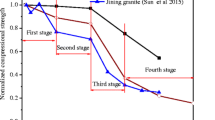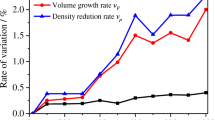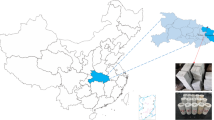Abstract
High temperature may lead to the development of new microcracks or growth of pre-existing microcracks within granite, varying its physical and mechanical properties. Experiments were conducted to study the evolution of the physical and mechanical properties of granite specimens from room temperature to 800 °C. The specimens were heated in heating furnace and uniaxial compression tests were done using MTS servo-controlled testing machine. The results indicate five phases in the variation of physical and mechanical properties with temperature: from room temperature to 100, 100–300, 300–400, 400–600, and 600–800 °C. The first phase corresponds to the vaporization-escaping interval of adhered water, bound water, and structural water. Larger changes of physical and mechanical parameters in the temperature range of 300–600 °C, mostly 400–600 °C, are probably caused by the transition from the brittle state to plasticity (or ductility) of granite, and 400 °C may be a critical threshold of its thermal damage. These results confirm the important link among physical and mechanical properties in response to thermal treatment.


















Similar content being viewed by others
References
Albaric J, Déverchère J, Petit C, Perrot J, Gall BL (2009) Crustal rheology and depth distribution of earthquakes: insights from the central and southern East African rift system. Tectonophysics 468:28–41
Alm O, Jaktlund LL, Kou SQ (1985) The influence of microcrack density on the elastic and fracture mechanical properties of stropa granite. Phys Earth Planet Inter 40:161–171
Anderson CA, Bridwell RJ (1980) A finite element method for studying the transient non-linear thermal creep of geological structures. Int J Rock Mech Min Sci Geomech Abstr 4:255–276
Bauer S J, Johnson B (1979) Effects of slow uniform heating on the physical properties of the westerly and charcoal granites. In: Proceedings of the 20th US symposium on rock mechanic, Austin, 4–6 June 1979, pp 7–18
Björnsson A (2008) Temperature of the Icelandic crust: inferred from electrical conductivity, temperature surface gradient, and maximum depth of earthquakes. Tectonophysics 447:136–141
Blanpied ML, Marone CJ, Lockner DA, Byerlee JD, King DP (1998) Quantitative measure of the variation in fault rheology due to fluid-rock interactions. J Geophys Res 103(B5):9691–9712
Chaki S, Takarli M, Agbodjan WP (2008) Influence of thermal damage on physical properties of a granite rock: porosity, permeability and ultrasonic wave evolutions. Constr Build Mater 22:1456–1461
Chen Y, Wang CY (1980) Thermally induced acoustic emission in Westerly granite. Geophys Res Lett 7(12):1089–1092
Chen Y, Wu XD, Zhang FQ (1999) Experimental research on rock thermal cracking (in Chinese). Chinese Sci Bull 44(8):880–883
Chen YL, Ni J, Shao W, Azzam R (2012) Experimental study on the influence of temperature on the mechanical properties of granite under un-axial compression and fatigue loading. Int J Rock Mech Min 56:62–66
Craig TJ, Copley A, Jackson J (2012) Thermal and tectonic consequences of India underthrusting Tibet. Earth Planet Sci Lett 353–354:231–239
Du SJ, Liu H, Zhi HT, Chen HH (2004) Testing study on mechanical properties of post-high-temperature granite (in Chinese). Chin J Rock Mech Eng 23(14):2359–2364
Dwivedi RD, Goel PK, Prasad VVR, Sinha Amalendu (2008) Thermo-mechanical properties of Indian and other granites. Int J Rock Mech Min 45:303–315
Etienne FH, Poupert R (1989) Thermally induced microcracking in granites: characterization and analysis. Int J Rock Mech Min Sci 26(2):125–134
Foulger GR (1995) The Hengill geothermal area, Iceland: variation of temperature gradients deduced from the maximum depth of seismogenesis. J Volcanol Geoth Res 65:119–133
Fredrich JT, Wong T (1986) Micromechanics of thermally induced cracking in three crustal rocks. J Geophys Res 91(B12):12743–12764
Géraud Y (1994) Variations of connected porosity and inferred permeability in a thermally cracked granite. Geophys Res Lett 21(11):979–982
Géraud Y, Mazerolle F, Raynaud S (1992) Comparison between connected and overall porosity of thermally stressed granites. J Struct Geol 14(8/9):981–990
Glover PWJ, Baud P, Darot M, Meredith PG, Boon SA, LeRavalec M, Zoussi S, Reuschlé T (1995) α/β phase transition in quartz monitored using acoustic emissions. Geophys J Int 120:775–782
Hajpal M (2002) Changes in sandstone of historical monuments exposed to fire or high temperature. Fire Technol 38(4):373–382
Heuze FE (1983) High-temperature mechanical, physical and thermal properties of granitic rocks—a review. Int J Rock Mech Min Sci Geomech Abstr 20(1):3–10
Jana J, Agnes K (2012) Thermally induced alterations of minerals during measurements of the temperature dependence of magnetic susceptibility: a case study from the hydrothermally altered soultz-sous-Forêts granite, France. Int J Earth Sci 101:819–839
Jason DP, Carlson SR, Young RP, Hutchins DA (1993) Ultrasonic imaging and acoustic emission monitoring of thermally induced microcracks in Lac du Bonnet Granite. J Geophys Res Solid Earth 98(B12):22231–22243
Jones C, Keaney G, Meredith PG et al (1997) Acoustic emission and fluid permeability measurements on thermally cracked rocks. Phys Chem Earth 22:813–817
Knapp RB, Norton D (1981) Preliminary numerical analysis of processes related to magma crystallisation and stress evolution in cooling pluton environments. Am J Sci 281:35–68
Koide H, Bhattacharji S (1975) Formation of fractures around magmatic intrusions and their role in ore localization. Econ Geol 70:781–799
Liu JR, Qin JS, Wu XD (2005) Experimental study on relation between temperature and rock permeability (in Chinese). J China Univ Pet Nat Sci 24(12):51–53
Lockner DA, Summers R, Byerlee JD (1986) Effects of temperature and sliding rate on frictional strength of granite. Pure appl Geophys 124(3):446–468
Lokajícek T, Rudajev V, Dwivedi RD et al (2012) Influence of thermal heating on elastic wave velocities in granulite. Int J Rock Mech Min 54:1–8
Mereer JJ (1973) Finite element approach to the modeling of hydrothermal systems. PhD dissertation, University of Illinois, Urbana
Nasseri MHB, Schubnel A, Young RP (2007) Coupled evolutions of fracture toughness and elastic wave velocities at high crack density in thermally treated westerly granite. Int J Rock Mech Min Sci 44:601–616
Nasseri MHB, Tatone BSA, Grasselli G, Young RP (2009) Fracture toughness and fracture roughness interrelationship in thermally treated Westerly granite. Pure Appl Geophys 166:801–822
Parish DK, Krivz AI, Carter NI (1976) Finite element folds of similar geometry. Tectonophysics 32:183–207
Pracht WE (1971) A numerical method for calculating transient creep flows. J Comp Phys 7:46–60
Ramdani F (1998) Geodynamic implications of intermediate-depth earthquakes and volcanism in the intraplate Atlas mountains (Morocco). Phys Earth Planet Inter 108:245–260
Rao GMN, Murthy CR (2001) Dual role of microcracks: toughening and degradation. Can J Earth Sci 38(2):427–440
Shimamoto T, Hara I (1976) Geometry and strain distribution of single-layer folds. Tectonophysics 30:1–34
Stesky RM (1978) Mechanisms of high temperature frictional sliding in Westerly granite. Can J Earth Sci 15:361–375
Sun Q, Zhang ZZ, Xue L, Zhu SY (2013) Physical–mechanical properties variation of rock with phase transformation under high temperature. (in Chinese). Chin J Rock Mech Eng 32(5):935–942
Xi BP, Zhao JC, Zhao YS, Zhu HH, Wu JW (2011) Key technologies of hot dry rock drilling during construction (in Chinese). Chin J Rock Mech Eng 30(11):2234–2243
Xu XC, Liu QS (2000) A preliminary study on basic mechanical properties for granite at high temperature (in Chinese). Chin J Geotech Eng 22(3):332–335
Xu XL, Gao F, Shen XM, Jin CH (2010) Research on mechanical characteristics and micropore structure of granite under high-temperature (in Chinese). Rock Soil Mech 31(6):1752–1758
Yang SF, Chen H, Jiang JS, Zhu GQ, Xie HS, Hou W, Zhang YM, Xu HG (1997) Testing study on elastic wave velocities and electrical conductivity of crustal rocks (in Chinese). Sci China Ser D 27(1):33–38
Yin TB (2012) Study on dynamic behavior of rocks considering thermal effect (in Chinese). Ph.D. Thesis, Central south university, Changsha
Zhang ZX, Yu J, Kou SQ, Lindqvist PA (2001) Effects of high temperatures on dynamic rock fracture. Int J Rock Mech Min 38(2):211–225
Zhang Y, Zhao YS, Wan ZJ, Qu F, Dong FK, Feng ZJ (2008) Experimental study on effect pore pressure on feldspar fine sandstone permeability under different temperatures (in Chinese). Chinese J Rock Mech Eng 27(1):53–58
Zhang Y, Zhao YS, Wu G (2010) Meso-structure and pattern of thermal cracking of Luhui granite (in Chinese). J Lanzhou Univ Technol 36(6):115–118
Zhi LP, Xu JY, Liu ZQ, Liu S, Chen TF (2012) Research on ultrasonic characteristics and Brazilian splitting-tensile test of granite under post-high temperature (in Chinese). Rock Soil Mech 33(s1):61–66
Acknowledgments
This research was supported by the State Basic Research and Development Program of China (No. 2013CB036003), the Priority Academic Program Development of Jiangsu Higher Education Institutions, Transport project (2013318J12330), and the National Science Youth Foundation of China (Grant No.41102201, No.41302233, No.51309222).
Author information
Authors and Affiliations
Corresponding author
Rights and permissions
About this article
Cite this article
Sun, Q., Zhang, W., Xue, L. et al. Thermal damage pattern and thresholds of granite. Environ Earth Sci 74, 2341–2349 (2015). https://doi.org/10.1007/s12665-015-4234-9
Received:
Accepted:
Published:
Issue Date:
DOI: https://doi.org/10.1007/s12665-015-4234-9




